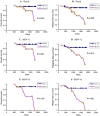Relationship between viral factors, axillary lymph node status and survival in breast cancer
- PMID: 16865407
- PMCID: PMC12160770
- DOI: 10.1007/s00432-006-0141-5
Relationship between viral factors, axillary lymph node status and survival in breast cancer
Abstract
Purpose: Our previous study based on the results of polymerase chain reaction and Southern hybridization for the detection of Human papilloma virus (HPV), Cytomegalovirus (CMV), Epstein-Barr virus (EBV), Herpes simplex virus (HSV)-1, HSV-2, and Human herpesvirus (HHV)-8 DNA in non-familial breast cancer patients suggest that the viruses associated with breast cancer are HHV-8 > EBV (P < 0.01). Therefore, efforts were made to further investigate the association between breast cancer with nodal status and viral infections.
Methods: Sixty-two breast cancer patients and their mammary specimens were enrolled in this retrospective study. The presence of these six potential oncogenic viruses was analyzed to establish the relationship between nodal status and treatment outcome. Statistical analyses were used for the assessment of variables, including viral positivity and clinical feature.
Results: Viral positivity was not significantly different comparing node-positive and node-negative patients (P > 0.05). When the viral factors were not entered for statistical analyses, no variable was significantly related to overall survival. However, tumor stage, tumor size, nodal status , and estrogen receptor were significantly related to relapse-free survival (P < 0.05). For viral factors, the number of infecting viruses is related to the overall and relapse-free survivals. Only when V0 or V(0, 1) was grouped for comparison with other multiply virus-infected subgroups, were the overall and relapse-free survivals significantly different (P < 0.005 or P < 0.001). The results suggest that HSV-1, HHV-8, EBV, CMV, and HPV were related to overall survival, however, only HHV-8 and CMV were related to relapse-free survival (P < 0.05 or P < 0.01).
Conclusion: Virus factor is significantly related to human breast cancer, not only in terms of the oncogenetic process, but also in overall and relapse-free survivals.
Figures


Similar articles
-
Viral DNAemia and DNA Virus Seropositivity and Mortality in Pediatric Sepsis.JAMA Netw Open. 2024 Feb 5;7(2):e240383. doi: 10.1001/jamanetworkopen.2024.0383. JAMA Netw Open. 2024. PMID: 38407904 Free PMC article.
-
Positron emission tomography (PET) and magnetic resonance imaging (MRI) for the assessment of axillary lymph node metastases in early breast cancer: systematic review and economic evaluation.Health Technol Assess. 2011 Jan;15(4):iii-iv, 1-134. doi: 10.3310/hta15040. Health Technol Assess. 2011. PMID: 21276372 Free PMC article.
-
Axillary treatment for operable primary breast cancer.Cochrane Database Syst Rev. 2017 Jan 4;1(1):CD004561. doi: 10.1002/14651858.CD004561.pub3. Cochrane Database Syst Rev. 2017. PMID: 28052186 Free PMC article.
-
Intra-mammary tumor location does not influence prognosis but influences the prevalence of axillary lymph-node metastases.J Cancer Res Clin Oncol. 2003 Sep;129(9):503-10. doi: 10.1007/s00432-003-0465-3. Epub 2003 Jul 18. J Cancer Res Clin Oncol. 2003. PMID: 12884027 Free PMC article.
-
Pre-treatment surgical para-aortic lymph node assessment in locally advanced cervical cancer.Cochrane Database Syst Rev. 2013 Mar 28;2013(3):CD008217. doi: 10.1002/14651858.CD008217.pub3. Cochrane Database Syst Rev. 2013. PMID: 23543561 Free PMC article.
Cited by
-
Human papillomavirus infection increases the risk of breast carcinoma: a large-scale systemic review and meta-analysis of case-control studies.Gland Surg. 2019 Oct;8(5):486-500. doi: 10.21037/gs.2019.09.04. Gland Surg. 2019. PMID: 31741879 Free PMC article.
-
Epstein-Barr virus as a marker of biological aggressiveness in breast cancer.Br J Cancer. 2011 Jan 18;104(2):332-7. doi: 10.1038/sj.bjc.6606048. Epub 2010 Dec 21. Br J Cancer. 2011. PMID: 21179039 Free PMC article.
-
Human cytomegalovirus infection is correlated with enhanced cyclooxygenase-2 and 5-lipoxygenase protein expression in breast cancer.J Cancer Res Clin Oncol. 2019 Aug;145(8):2083-2095. doi: 10.1007/s00432-019-02946-8. Epub 2019 Jun 15. J Cancer Res Clin Oncol. 2019. PMID: 31203442 Free PMC article.
-
PDGFRα Enhanced Infection of Breast Cancer Cells with Human Cytomegalovirus but Infection of Fibroblasts Increased Prometastatic Inflammation Involving Lysophosphatidate Signaling.Int J Mol Sci. 2021 Sep 10;22(18):9817. doi: 10.3390/ijms22189817. Int J Mol Sci. 2021. PMID: 34575976 Free PMC article.
-
Human cytomegalovirus infection enhances NF-κB/p65 signaling in inflammatory breast cancer patients.PLoS One. 2013;8(2):e55755. doi: 10.1371/journal.pone.0055755. Epub 2013 Feb 13. PLoS One. 2013. PMID: 23418456 Free PMC article.
References
-
- Breslin TM, Cohen L, Sahin A, Fleming JB, Kuerer HM, Newman LA, Delpassand ES, House R, Ames FC, Feig BW, Ross MI, Singletary SE, Buzdar AU, Hortobagyi GN, Hunt KK (2000) Sentinel lymph-node biopsy is accurate after neoadjuvant chemotherapy for breast cancer. J Clin Oncol 18:3480–3486 - PubMed
-
- Brower V (2004) Accidental passengers or perpetrators? Current virus-cancer research. J Natl Cancer Inst 96:257–258 - PubMed
-
- Catzeddu T, Bertelli G, Del Mastro L, Venturini M (2004) Sentinel lymph-node biopsy in breast cancer patients: the medical oncology perspective. J Surg Oncol 85:129–132 - PubMed
-
- Cengiz O, Bozkurt B, Unal B, Lana AM, Essner R, Wen DR (2004) The relationship between prognostic factors of breast cancer and thyroid disorders in Turkish women. J Surg Oncol 87:19–25 - PubMed
-
- Chu JS, Chen CC, Chang KJ (1998) In situ detection of Epstein-Barr virus in breast cancer. Cancer Lett 124:53–57 - PubMed
Publication types
MeSH terms
Substances
LinkOut - more resources
Full Text Sources
Medical

